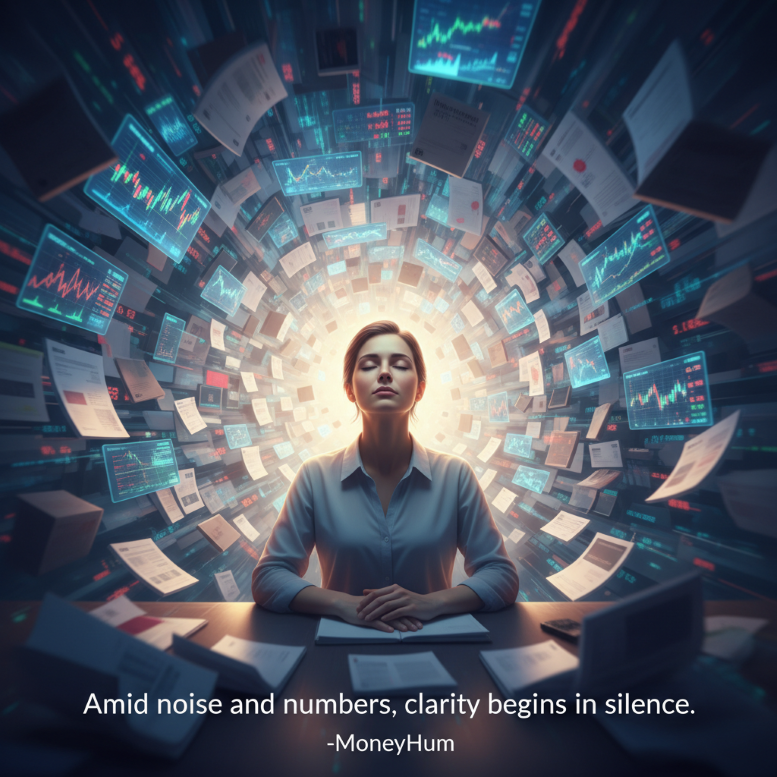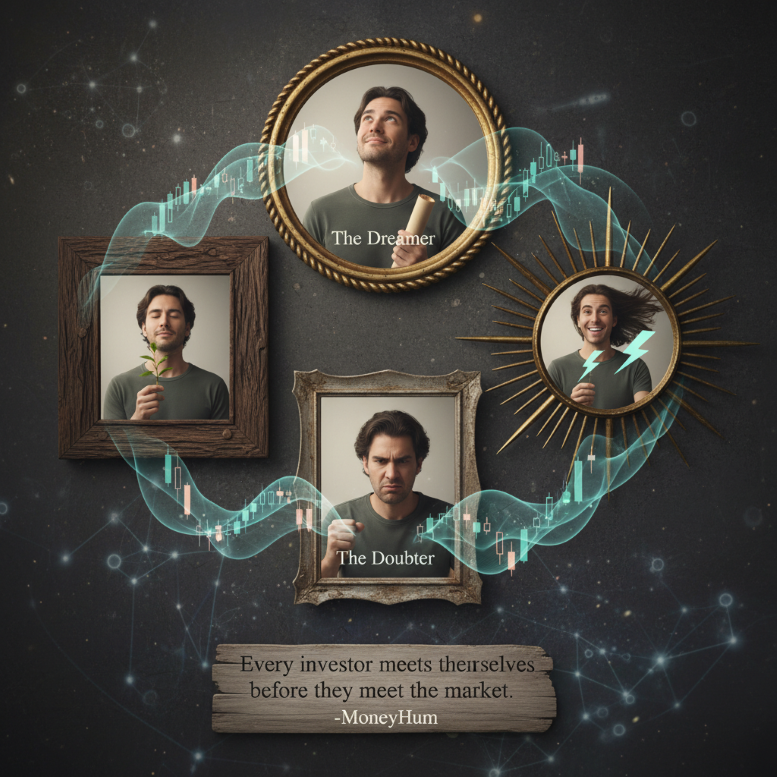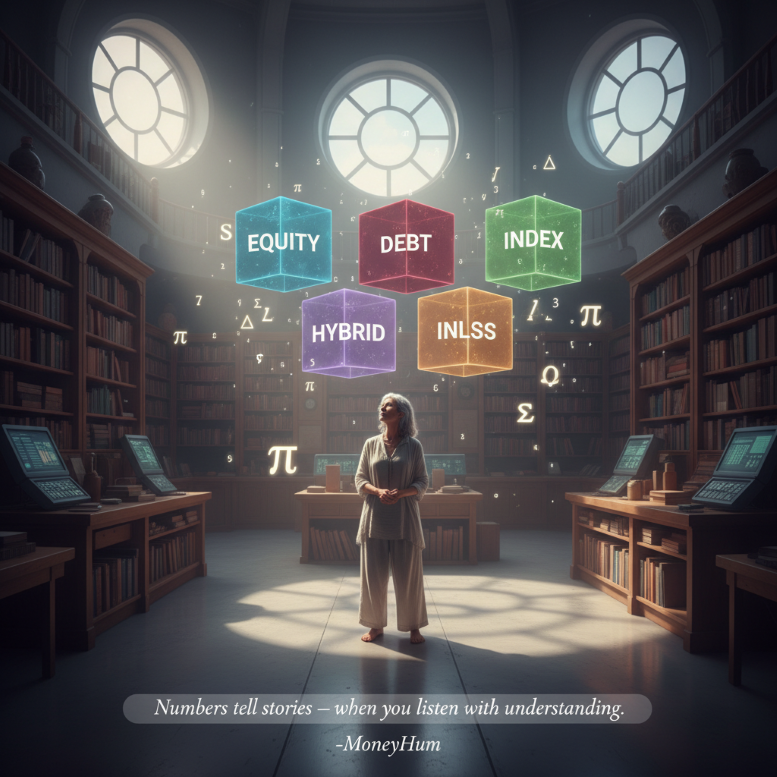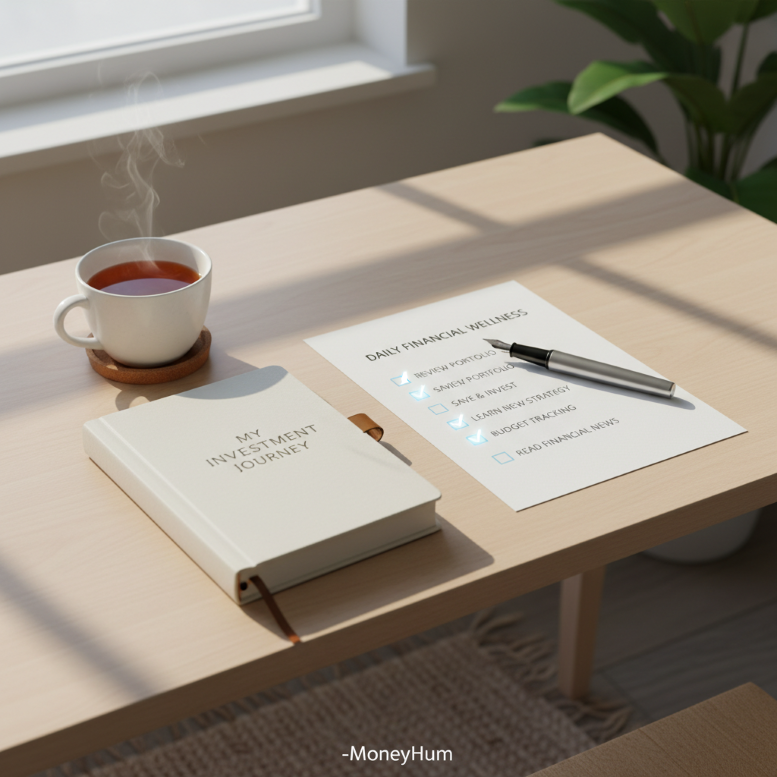Chapter I
The Paradox of Choice: Why Mutual Fund Selection is Overwhelming
You open your investment app.
There are hundreds of options Large Cap, Small Cap, Mid Cap, ELSS, Index, Balanced Advantage, Sectoral, Focused, Flexi Cap…
Each fund seems to have performed differently, managed by someone whose name you have never heard but whose graph looks impressive.
One YouTuber says, “Go for small caps, they give the highest returns.”
Another insists, “Only index funds work don’t chase alpha.”
Your colleague says, “I made 30% in this one last year!”
And your mind quietly exhausted whispers, “What if I choose wrong?”
This is where most investors pause, not because they do not want to invest, but because they are afraid to decide.
The fear is not just of losing money it is the fear of being wrong.
And in that subtle fear lies the emotional heart of investing.

Overcoming Decision Fatigue and Choice Paralysis in Investing
If you have ever spent hours comparing mutual funds and ended up investing in none you have experienced choice paralysis.
Psychologists call it decision fatigue the mental exhaustion that sets in when faced with too many options.
A study by Barry Schwartz in The Paradox of Choice revealed that while more choices promise freedom, they actually create anxiety, guilt, and self doubt.
When everything looks “almost right,” your brain refuses to pick one because commitment feels like closing the door to something better.
That is why, in the Indian investing landscape flooded with advice reels, return comparisons, and top 10 fund lists people often wait instead of start.
But here is the truth no financial influencer tells you:
“You don’t need the best mutual fund you need the right one for your temperament.”
The best fund changes every year.
The right fund stays right for you across decades.
Understanding Behavioral Patterns and Emotional Triggers in Investing
Let us pause and go inward for a moment.
When you think about investing, what is your first emotional response?
- Is it curiosity wanting to learn and grow wealth quietly?
- Or anxiety fearing loss or complexity?
- Or impatience wanting faster results, quicker gains?
Each emotion tells a story.
And that story shapes how you choose and stay with your investments.
A 2022 study by the Indian Institute of Management (IIM) on Behavioral Patterns in Retail Investing found that emotional triggers not information gaps are the biggest reason for poor investment outcomes.
Let us explore a few of these patterns you might recognize:
Emotional Archetype 1: The Overthinker’s Loop (Fear of Mistake)
You research deeply. You open AMFI, ValueResearch, ET Money, Morningstar read everything.
You shortlist three funds then reopen YouTube.
One new video makes you question it all.
So, you wait.
And in waiting, months pass.
Emotional driver: Fear of making a mistake.
Result: You lose time the most irreplaceable compounding factor.
Emotional Archetype 2: The Return Chaser (FOMO & Comparison Bias)
You see your friend’s portfolio up 25%. You feel inspired, maybe envious.
You buy the same fund only for it to underperform next year.
You exit.
Then repeat with another “trending” fund.
Emotional driver: FOMO and comparison bias.
Result: You get returns lower than even average funds because you kept switching.
(Read: Why You Keep Chasing Quick Profits)
Emotional Archetype 3: The Avoider (Financial Anxiety)
You know you should invest. You have bookmarked SIP calculators.
But every time you think of “Mutual Funds,” your chest tightens too technical, too risky, too much.
So, you park money in a savings account, telling yourself you will “start when you understand it fully.”
Emotional driver: Financial anxiety, often inherited from seeing money as unstable.
Result: Comfort now, regret later.
(Read more: Financial Anxiety Is the Modern Disease: How to Heal Money Fear & Stress)
Emotional Archetype 4: The Builder (Calm & Consistency)
You pick one fund, set a SIP, and do not look at it daily.
You trust the process, track annually, and stay steady through market ups and downs.
Emotional driver: Calm confidence, built on understanding that volatility is normal.
Result: True wealth both financial and emotional over time.
The Investor’s Real Test: Patience and Self-Trust Over Market Intelligence
Here is the emotional truth about investing:
“The market doesn’t test your intelligence. It tests your patience and self trust.”
Mutual funds are not IQ exams.
They are psychological mirrors.
They reveal your tolerance for uncertainty, your relationship with control, and your ability to let time do its quiet work.
Before you learn “how to choose a fund,” it helps to understand why choosing feels difficult.
Because once you see the emotion clearly, it loses power over you.
Let us name those emotions:
- Fear “What if I lose money?”
- Shame “I should have started earlier.”
- Confusion “There is too much information.”
- Comparison “Others seem smarter.”
- Doubt “Am I doing this right?”
Every investor carries these, quietly.
But growth begins not when these feelings disappear but when you make peace with them and still take the next small, informed step.
Building Alignment: Choosing a Mutual Fund Partner for Your Temperament
Think of choosing a mutual fund not as finding perfection but as building alignment.
You are not selecting a product.
You are choosing a long term partner for your financial journey.
When you choose a partner in life, you do not ask: “Who is perfect?”
You ask: “Who is right for me for who I am and what I value?”
The same goes for funds.
Your choice should reflect:
- Your temperament toward risk,
- Your time horizon,
- Your emotional capacity to stay invested when markets fall.
Because markets will fall sometimes sharply, sometimes suddenly.
And in those moments, your fund’s name matters less than your ability to stay the course.
The Real Foundation of Good Investing: Awareness and Self-Knowledge
If you are feeling that mix of curiosity and confusion right now that is good.
It means you are awake, aware, and ready to learn not react.
And that awareness is the real foundation of good investing.
As you will see in the next chapter, the most successful investors are not the ones with the highest returns they are the ones with the most self knowledge.
Chapter II
Investor Psychology: Understanding Your Temperament Before Selecting a Fund
The Right First Question: Who Am I When Dealing with Investment Uncertainty?
Most people start their investing journey with a simple, logical question:
“Which mutual fund should I invest in?”
But beneath that question, something deeper is being asked:
“Who am I when I deal with uncertainty?”
Because mutual funds are not just about returns and charts they are about behavior.
The same fund that made one person rich has made another lose sleep.
The difference was not the fund.
It was the fit.
Before you chase the next top rated scheme, pause and look inward.
Mutual funds are mirrors. They show you not only how the market moves, but how you move emotionally, mentally, and habitually when money is involved.
Four Investor Archetypes: Finding the Right Fund Fit for Your Personality

Let us begin with a simple truth:
Your portfolio is a reflection of your personality.
Some investors find calm in slow, steady returns.
Others crave the thrill of growth the adrenaline of upward graphs.
Some can sit through market crashes with quiet faith.
Others feel a knot in their stomach when the index dips by even 2%.
Neither is wrong.
But each requires a different kind of fund and a different kind of relationship with it.
Over time, I have seen that most investors fit into one (or a blend) of four archetypes.
These are not categories to label you but mirrors to help you recognize yourself.
So, read gently. Reflect. There is no judgment here, only understanding.
The Dreamer Archetype: Ideal Funds and Behavioral Bias (Recency Bias)
The Dreamer invests because they want to believe in a better future.
They are driven by vision to travel more, retire early, buy peace for their parents, or build something meaningful.
But the Dreamer’s challenge is impatience.
They often say things like:
- “My SIP has not grown much this year.”
- “Maybe this fund is not working.”
- “What if I switch to the one that is performing better?”
They see investing as a race, not a rhythm.
Psychology:
The Dreamer’s mind is emotionally charged hopeful yet restless.
They are more influenced by external stimuli (news, influencers, peers).
They overestimate short term impact and underestimate compounding.
Behavioral bias: Recency bias the tendency to believe recent trends will continue indefinitely.
Ideal Fund Fit:
Balanced or Hybrid funds, or broad based Index funds (Nifty 50, Sensex).
They provide growth and stability helping the Dreamer stay invested long enough to witness compounding.
Advice:
“Let your hope be your reason to start not your reason to rush.”
(Read: The Path to Real Wealth: Why Patience and Compounding Beat Shortcuts)
The Doubter Archetype: Ideal Funds and Behavioral Bias (Loss Aversion)
The Doubter reads everything before investing.
They know what CAGR means, how NAV works, even the SEBI fund classifications.
But they are still waiting for the “right moment.”
They say:
- “The market is at an all time high.”
- “Let me wait for the next correction.”
- “I will invest once I am sure this is not a bubble.”
The Doubter’s world is filled with knowledge and hesitation.
They confuse knowing more with doing better.
Psychology:
The Doubter seeks control.
They believe that with enough information, they can eliminate uncertainty.
But investing, by nature, is uncertainty the art of making peace with incomplete information.
Behavioral bias: Loss aversion the pain of losing ₹1 feels stronger than the joy of gaining ₹2.
They avoid risk even when it is rationally worth taking.
Ideal Fund Fit:
Large Cap or Conservative Hybrid funds.
They offer predictable growth, stable performance, and fewer emotional shocks.
Advice:
“You don’t overcome fear by removing uncertainty you overcome it by learning to move with it.”
(Read: Financial Anxiety Is the Modern Disease: How to Heal Money Fear & Stress)
The Chaser Archetype: Ideal Funds and Behavioral Bias (Overconfidence & FOMO)
The Chaser does not wait. They act.
They love market energy bull runs, IPOs, trending funds.
They enter quickly, and sometimes, exit quicker.
Their energy is unmatched, but their patience is thin.
They say:
- “Why settle for 12% when this fund gave 20% last year?”
- “Midcaps are on fire right now I am moving my SIP there.”
- “I am booking profits; I will re enter later.”
Psychology:
The Chaser’s motivation is not greed it is validation.
They want to feel smart, in control, and ahead of others.
They find stillness boring and volatility thrilling.
Behavioral bias: Overconfidence & FOMO.
The Chaser believes timing is everything until timing fails.
Ideal Fund Fit:
Flexi cap or Multi cap funds, where they can benefit from diversification without needing to switch.
They should automate SIPs and avoid tracking NAV daily.
Advice:
“Your brilliance shows not in catching trends but in resisting them.”
(Read: Why You Keep Chasing Quick Profits)
The Builder Archetype: Ideal Funds and Behavioral Strength (Long-Term Thinking)
The Builder understands one quiet truth:
Markets are not linear, but time is fair.
They do not get swayed by market noise.
They invest month after month, year after year not because they are unemotional, but because they have made peace with emotion.
They say things like:
- “It is okay, markets fall. They will rise again.”
- “I am focusing on my time in the market, not timing it.”
- “My SIP is my peace of mind.”
Psychology:
The Builder has emotional maturity they do not confuse temporary volatility with permanent loss.
They understand the psychology of enough.
Behavioral strength: Self trust and long term thinking.
Ideal Fund Fit:
Index funds, ELSS, or diversified equity funds anything that rewards patience.
Advice:
“Peace is the best indicator of a good portfolio.”
(Read: Build a Strong SIP Habit: Your Simple 12-Month Plan for Beginners)
Applying Investor Archetypes to Align Fund Choice with Temperament
Now that you have met these archetypes, ask yourself:
- Which one feels most like you?
- Which one do you aspire to be more like?
Maybe you are 60% Doubter, 30% Dreamer, 10% Chaser.
That is okay.
This is not about labeling it is about recognizing patterns that help you choose funds that align with your temperament.
For example:
- If you are a Doubter, start small even ₹500 SIPs to experience emotional comfort.
- If you are a Chaser, set an auto SIP and hide the app for a while.
- If you are a Dreamer, revisit your goals quarterly, not daily.
- If you are a Builder, consider gradually adding index funds or ELSS to maximize discipline.
Your investment plan should not fight your nature.
It should flow with it gently, logically, sustainably.
Emotional vs. Mathematical Risk: Defining Your True Risk Tolerance
Risk is not just mathematical.
It is emotional.
When SEBI defines a fund as “high risk,” they mean volatility.
When your heart defines it as “high risk,” it often means fear of loss, fear of regret, or fear of judgment.
That is why two people can look at the same graph and feel opposite things one sees opportunity, the other sees danger.
Understanding this helps you stop comparing yourself with others.
Because your risk tolerance is not a number.
It is a combination of your personality, your life stage, and your emotional endurance.
Alignment over Perfection: The Meaning of the “Right” Mutual Fund
Let us imagine two investors: Meera and Arjun.
- Meera is calm but cautious. She chooses a balanced fund and sets a SIP.
- Arjun is driven and curious. He picks two equity funds one index, one flexi cap.
A year later, both are happy not because they made the same return, but because they made aligned choices.
Their funds fit who they are.
That is what “the right mutual fund” truly means not perfection, but alignment.
Not chasing the top fund but finding the fund that lets you stay consistent.
The Most Powerful Investment: Self-Knowledge in the Financial Journey
As you prepare to explore returns, risk, and categories in the next chapter, pause and ask yourself:
“What kind of investor do I want to become not just for my money, but for my mind?”
Because the way you invest is often the way you live:
- Are you patient or hurried?
- Are you reactive or reflective?
- Are you chasing or building?
The most powerful investment you will ever make is not in a fund it is in knowing yourself.
Chapter III
Mutual Fund Fundamentals: Key Metrics, Types, and the Power of Compounding
Structure Meets Self-Knowledge: The Mathematical Backbone of Mutual Funds
By now, you have begun to understand that choosing the right mutual fund is not about outsmarting the market it is about understanding yourself.
But self knowledge must meet structure.
Because clarity without framework is like faith without direction comforting, but incomplete.
In this chapter, we will walk through the mathematical and structural backbone of mutual funds not with the cold tone of a textbook, but with the calm of understanding what truly matters.
You will see that numbers, when explained gently, are not intimidating.
They are simply stories about time, discipline, and trust.
The Philosophy of Mutual Funds: Structure that Rewards Emotional Steadiness
At its simplest, a mutual fund is a group investment.
You, along with thousands of other investors, pool money together.
A professional fund manager invests that pool into various assets equities, bonds, or both.
Each rupee earns according to the overall performance of those assets.
But beneath this simplicity lies a deeper philosophy:
“A mutual fund is not a shortcut to wealth it’s a structure that rewards emotional steadiness.”
Mutual funds democratize investing.
They allow ordinary people to participate in markets that once belonged only to the wealthy or well informed.
But that power also comes with noise thousands of schemes, hundreds of fund houses, endless “top 10” lists.
So let us build calm through structure.

Five Core Mutual Fund Categories by Risk, Goal, and Time Horizon
When stripped to essence, all funds fit into five main categories each suited to a certain temperament and time horizon.
Category 1: Equity Funds (High Volatility, High Potential for Long Term)
These funds invest primarily in company stocks.
You are not lending money; you are owning a part of a business.
- Who they suit: Long term investors (5+ years).
- Risk: High short term volatility, high long term potential.
- Emotional need: Patience and faith in compounding.
Subcategories:
- Large Cap Funds: Invest in established companies like HDFC, Infosys, Reliance. Steady, less volatile.
- Mid Cap Funds: Slightly smaller firms with growth potential. More volatility, higher returns possible.
- Small Cap Funds: Emerging businesses. High risk, high reward.
- Flexi/Multi Cap: Mix of all sizes; offers balance.
- Sectoral/Thematic Funds: Focused on one sector (IT, Pharma, EV). Risky and cyclical best for experienced investors.
📊 Example:
Invest ₹10,000 per month in a Large Cap Fund for 20 years at 12% annualized return → ₹10,000 x 240 months grows to nearly ₹98 lakh.
The math is simple. The patience is not.
Category 2: Debt Funds (Lower Risk, Ideal for Safety and Short-Term Goals)
Debt funds invest in government bonds, corporate deposits, and short term papers.
Here, you are lending money not owning companies.
- Who they suit: Conservative investors or those nearing financial goals.
- Risk: Lower than equity, but returns fluctuate with interest rates.
- Emotional need: Safety, predictability.
Subcategories:
- Liquid Funds: Ideal for parking idle money short term (better than savings account).
- Short Term Funds: Hold for 1–3 years.
- Gilt Funds: Invest in government securities safest in credit risk, but sensitive to rate changes.
📈 Example:
₹1 lakh in a liquid fund earning 6.5% yearly → ₹1,06,500 after a year, with better post tax efficiency than a savings account (especially for those in higher tax brackets).
Category 3: Hybrid Funds (Moderate Risk, Balanced Growth with Stability)
These funds blend equity and debt in various proportions, offering a balanced experience.
- Who they suit: New investors or those seeking moderate growth with stability.
- Risk: Moderate cushions volatility.
- Subcategories:
- Aggressive Hybrid: ~65% equity, 35% debt.
- Balanced Advantage (Dynamic): Shifts allocation based on market conditions.
This is often a perfect place to begin your investing journey.
It is like learning to swim in the shallow end before diving deep.
Category 4: Index Funds (Market Return, Low Expense Ratio, High Consistency)
Index funds simply mirror a market index (like Nifty 50 or Sensex).
They do not try to beat the market; they become the market.
- Who they suit: Investors who value consistency, not constant monitoring.
- Risk: Market risk only no fund manager bias.
- Return: Usually slightly lower than actively managed funds, but with lower expenses and higher predictability.
“Sometimes, simplicity is the ultimate sophistication.”
Leonardo da Vinci, if he were an investor.
(Read: The Path to Real Wealth: Why Patience and Compounding Beat Shortcuts)
Category 5: ELSS Funds (Tax Efficiency with 3-Year Lock-in Equity Exposure)
ELSS funds are equity mutual funds under Section 80C that offer tax deduction up to ₹1.5 lakh/year.
They have a 3 year lock in short enough to be liquid, long enough to teach patience.
- Who they suit: Salaried individuals seeking tax efficiency and market exposure.
- Risk: Equity risk; treat 3 years as minimum, not maximum.
- Return: Historically 10–14% over 10 years, depending on market cycles.
(Read: Build a Strong SIP Habit: Your Simple 12-Month Plan for Beginners)
Essential Mutual Fund Metrics: NAV, Expense Ratio, Alpha, Beta, and Sharpe Ratio
Now that you understand the landscape, let us zoom into the mathematical DNA of mutual funds the ratios and figures often thrown around without clarity.
Each number tells a story and like all stories, you only need to understand the meaning, not memorize the formula.
Understanding NAV (Net Asset Value): Not a Stock Price
The price per unit of your mutual fund.
If the fund’s total assets (stocks, bonds) minus liabilities are worth ₹1,000 crore and there are 10 crore units, NAV = ₹100.
👉 But NAV is not like a stock price.
A higher NAV does not mean “expensive,” and a lower one does not mean “cheap.”
It is just an accounting value what matters is the growth rate of that NAV over time.
The Importance of Expense Ratio: The Silent Leak in Long-Term Returns
Every fund charges a small fee for management this is the expense ratio, expressed as a percentage.
- If your fund’s expense ratio is 1%, and your total value is ₹1 lakh, you pay ₹1,000 per year indirectly.
- Index funds often have expense ratios below 0.3%.
- Actively managed funds range from 0.8–1.5%.
A difference of even 1% compounded over 20 years can reduce your returns by lakhs.
📊 Example:
₹10,000/month SIP for 20 years at 12% = ₹98 lakh.
At 11% (because of higher expenses) = ₹86 lakh.
That is ₹12 lakh lost not due to bad investing, but due to quiet inefficiency.
So, check expense ratios carefully.
Sometimes, the cheaper fund quietly wins the race.
Alpha and Beta: Measuring Fund Outperformance and Market Volatility
- Alpha: Measures how much the fund outperformed its benchmark (e.g., Nifty 50).
- Alpha = +2 → performed 2% better than benchmark.
- A consistent positive alpha shows skill.
- Beta: Measures volatility compared to the market.
- Beta = 1 → moves with the market.
- Beta > 1 → more volatile.
- Beta < 1 → more stable.
For new investors, chasing high alpha is less important than finding consistency and reasonable volatility (Beta around 0.9–1.1).
Sharpe Ratio: Efficiency of Return per Unit of Risk Taken
A higher Sharpe Ratio means the fund gives better returns for the risk taken.
It is like measuring how efficiently a car uses fuel more mileage per litre, more Sharpe per risk.
Ideal: Sharpe > 1 is considered good.
But context matters; compare within the same category (e.g., Equity vs Equity).
Standard Deviation: Measuring the Rollercoaster Factor (Fund Volatility)
This measures how much the fund’s returns deviate from its average.
A high standard deviation means bumpy rides; a low one means smoother.
This matters not only mathematically but emotionally:
Can you stay invested when your fund fluctuates 15% in a month?
If not choose lower volatility options.
The Most Powerful Formula: Future Value and the Power of Consistency
Let us look at the simplest, most powerful formula you will ever need:
Future Value = Present Value × (1 + r)^t
Where r = rate of return, t = time in years.
But the secret is not in the formula it is in the behavior it rewards.
A 25 year old investing ₹10,000/month for 30 years at 12% earns ₹3.5 crore.
A 35 year old starting with the same amount earns ₹1 crore less just because of 10 lost years.
That is not the power of math.
That is the power of consistency the quiet magic of doing small things for a long time.
(Read: The Hidden Cost of Constant Hustle: Why Doing Less Earns More)
Why Emotion Matters: The Relationship with Uncertainty in Investing
You might wonder why talk about emotion in a math chapter?
Because numbers do not exist in isolation.
You can understand alpha, beta, and Sharpe perfectly, yet panic sell when the market dips 10%.
That is because investing is not just an equation of return it is a relationship with uncertainty.
Mathematics gives clarity.
Emotion gives endurance.
And together, they form wisdom.
Chapter IV
The 10-Point Mutual Fund Selection Checklist for Calm and Consistent Investing
The Power of Alignment: Choosing a Fund that Fits Your Goals and Temperament
You have reflected deeply. You have understood your emotions, your archetype, and the numbers that shape the investing world.
Now comes the quiet but powerful step choosing your fund.
This is where most people freeze again not from ignorance, but from perfectionism.
They want the perfect fund.
The one that never falls.
The one that grows fast, yet never feels risky.
The one that performs every year without fail.
It does not exist.
But what does exist and works beautifully is alignment.
When your chosen fund fits your goals, temperament, and time horizon, peace follows naturally.
Let us now build that alignment, step by step.
The Right Mutual Fund Checklist: Bridging Psychology, Math, and Practice

This is not a “pick and go” checklist.
It is a framework for calm thinking a mirror for self alignment.
Each point bridges psychology, math, and practice.
Checklist Step 1: Define Your Goal and Time Horizon Clearly
Before you open an investing app, write down what are you investing for?
- A short term goal (like a car or home down payment)?
- Medium term (child’s education, starting a business)?
- Long term (retirement, financial independence)?
Each goal has its own temperament, and therefore, its own type of fund.
Rule of thumb:
- Goals < 3 years → Debt or Liquid Funds.
- Goals 3–5 years → Balanced/Hybrid Funds.
- Goals > 5 years → Equity or Index Funds.
But the goal is not just what you want it is how you want to feel along the way.
If watching volatility makes you anxious, pick funds that protect your calm first, growth second.
(Read: Financial Anxiety Is the Modern Disease: How to Heal Money Fear & Stress)
Checklist Step 2: Set a Time Horizon as a Contract with Your Future Self
A time horizon is not a deadline it is a contract between you and your future self.
If you say, “I am investing for 10 years,” then honor that even when the market crashes in year 2.
Time does not erase volatility it smooths it.
The longer your horizon, the gentler the market becomes.
📊 Illustration:
- Nifty 50 has never given negative returns over any 10 year rolling period since inception.
- But in shorter periods (1–3 years), volatility is common and natural.
So, before you start, whisper this to yourself:
“I am not investing for the next quarter I am investing for the next chapter of my life.”
Checklist Step 3: Assess Emotional Endurance and True Risk Tolerance
Risk tolerance is not about bravery.
It is about emotional endurance.
Ask yourself:
- Can I handle seeing a 10% return without panic?
- Would I feel anxious checking NAV daily?
- Or can I stay calm knowing volatility is temporary?
If small losses make you restless choose hybrid or large cap funds.
If you can watch red numbers and still stay consistent equity or index funds will reward your patience.
Risk tolerance is self knowledge in disguise.
The key is not to eliminate fear, but to understand it.
(Read: Why You Keep Chasing Quick Profits)
Checklist Step 4: Choose the Fund Category Based on Emotional Logic
When you go fund hunting, start broad.
Choose the category, not the brand.
Here is the emotional logic behind each:
| Category | For Whom | Emotion It Rewards |
|---|---|---|
| Equity (Large Cap) | Patient Builder | Trust |
| Mid/Small Cap | Growth Seeker | Courage |
| Hybrid | Balanced Thinker | Stability |
| Index | Simplicity Seeker | Peace |
| Debt | Cautious Planner | Safety |
| ELSS | Purposeful Investor | Discipline |
Once you know your category, then shortlist 2–3 funds within it.
This prevents “choice fatigue” and brings calm focus.
Checklist Step 5: Evaluate Consistency, Expense Ratio, and Manager Tenure
Now, look at numbers but gently.
Past performance does not guarantee the future, yet it reveals behavior.
What to check:
- 5 year & 10 year consistency: Did it stay above its benchmark in most years?
- Expense Ratio: Lower is better (especially for index and debt funds).
- Fund Manager Tenure: 3+ years under same manager = stability.
- AUM (Assets Under Management): Not too small (unstable), not too massive (slow moving).
Do not be seduced by one year returns.
They are often like social media highlights filtered, temporary, exaggerated.
Instead, look for funds that have quietly outperformed across multiple cycles bull and bear alike.
Checklist Step 6: Automate Your SIP for Emotional and Financial Discipline
SIPs (Systematic Investment Plans) are not just tools they are emotional systems.
They protect you from impulsive decisions, procrastination, and market timing.
When you automate your SIP, you are saying:
“I trust process more than prediction.”
It is the same as setting a morning alarm for your dreams automatic, gentle, non negotiable.
📈 Example:
₹5,000/month for 15 years at 12% = ₹25 lakh invested → ₹50 lakh corpus.
₹10,000/month for same duration = ₹1 crore.
Small decisions, multiplied by time, become miracles.
(Read: Build a Strong SIP Habit: Your Simple 12-Month Plan for Beginners)
Checklist Step 7: Diversify Wisely to Avoid Overlap and Emotional Clutter
Diversification is wisdom.
Over diversification is confusion.
Ideally:
- 1–2 equity funds (different styles)
- 1 hybrid fund
- 1 debt or liquid fund for emergencies
Too many funds = overlap + emotional clutter.
You do not need 12 funds to feel secure.
You need 3–4 good ones you understand and trust.
Checklist Step 8: Review Annually to Rebalance Quietly, Not Reactively
Checking your fund every week does not make you disciplined it makes you anxious.
Review once a year.
Ask three questions:
- Is the fund still consistent within its category?
- Has my goal or risk tolerance changed?
- Is the expense ratio or fund strategy stable?
If yes, stay invested.
If no, rebalance quietly no drama, no panic.
Remember: Rebalancing is evolution, not reaction.
(Read: Your Financial System Needs a Dashboard — Not Just Dreams)
Checklist Step 9: Align Investments with Your Emergency Fund, Insurance, and Debt
Your investments should not exist in isolation.
They should live in harmony with your:
- Emergency fund
- Insurance
- Debt management
- Monthly budget
When these four are aligned, money stops being a stressor and starts being a stabilizer.
Link it emotionally to your life’s rhythm not your market app.
(Read: How to Measure Real Progress in Life (When Money Isn’t Enough)
Checklist Step 10: Trust Time, Consistency, and the Power of Compounding
The world’s best investors from Warren Buffett to Rakesh Jhunjhunwala share one trait:
They stayed.
They understood that no model, algorithm, or intuition can outsmart time.
Because compounding is not a formula it is a relationship with patience.
📊 Perspective:
A 20 year SIP at 12% doubles roughly every 6 years.
Which means every 6 years, you are not just earning you are growing who you are.
Let the calendar do what calculators cannot.
The Inner Checklist: Essential Questions Before Clicking “Invest”
Before you click “Invest,” take a quiet moment. Ask yourself:
- Am I investing to grow, or to prove something?
- Am I choosing this fund because I understand it, or because someone praised it?
- Will I still hold this when the market corrects 20%?
- Does this choice make me feel peaceful or restless?
Because the most powerful indicator of the right mutual fund is peace not performance.
Example Portfolio Template for Different Goals and Time Horizons
| Goal | Time Horizon | Fund Type | Example |
|---|---|---|---|
| Emergency | 0–1 yr | Liquid Fund | Parag Parikh Liquid, Nippon Liquid |
| Short Term Goal | 1–3 yrs | Debt/Hybrid | ICICI Prudential Balanced Advantage |
| Long Term Growth | 5+ yrs | Index / Flexi Cap | Axis Bluechip, UTI Nifty 50 Index |
| Tax Saving | 3+ yrs | ELSS | Mirae Asset Tax Saver |
This is not a prescription it is a template for calm.
Choose funds that mirror your temperament not just the top of the charts.
The Ultimate Goal: Peace in Progress Over Perfection
There will never be a perfect fund.
But there will always be a right one for you right now.
It is the one you understand, can stay with emotionally, and can commit to consistently.
The purpose of this checklist is not to make you a finance expert.
It is to help you feel something rarer peace in progress.
Because wealth is not just what compounds in your account it is what compounds in your character.
Chapter V
The Inner Return: Emotional Compounding and Measuring Wealth in Peace

Investing for Peace: The Goal Beyond Financial Wealth
There is a moment every investor eventually meets.
It comes late at night, when the screens are off, and the markets are done for the day.
You glance at your portfolio it is neither green nor red, just still.
And in that stillness, you ask yourself quietly:
“Is this really working? Am I growing or just waiting?”
It is in that moment you realize something profound:
We do not invest only for wealth.
We invest for peace.
The goal was never just to make money.
It was to make sense of our fears, our patience, our priorities.
Because money, when handled with awareness, becomes a mirror.
And what it reflects is not just your net worth it is your self worth.
Overcoming Loss Aversion: The Emotional Reward of Staying Consistent
When the market falls, your screen shows red.
But your mind shows something else: doubt.
- “Should I stop my SIP?”
- “Maybe I entered at the wrong time.”
- “What if this never recovers?”
That voice fearful, urgent, uncertain is the voice of our survival instinct.
It is ancient.
Our brains evolved to react to danger, not to stay calm during 20% corrections.
Behavioral economics calls this loss aversion the tendency to feel pain twice as strongly as pleasure.
It is why we remember losses vividly, but forget steady years of gains.
And yet, those who stay who breathe through panic and hold through fear are rewarded not just financially, but emotionally.
They develop something rare: emotional compounding.
Emotional Compounding: Growing Inner Stability Through Consistent Action
You already know how financial compounding works:
Small, consistent actions grow exponentially over time.
But there is a hidden twin to that concept:
Emotional compounding the quiet growth of your inner stability through consistent, patient action.
Each SIP you continue despite doubt compounds your confidence.
Each year you resist comparison compounds your focus.
Each crash you endure compounds your wisdom.
The longer you stay invested the less markets scare you, and the more you trust yourself.
This is the point where investing becomes meditation.
Discipline becomes devotion.
And patience, your most valuable asset class.
(Read also: The Path to Real Wealth: Why Patience and Compounding Beat Shortcuts)
From Chasing Returns to Chasing Alignment and Peace
In the beginning, most investors chase outcomes
“How much return can I get?”
But seasoned investors chase alignment
“Is my money growing in harmony with my life?”
That shift changes everything.
Because success stops being measured in percentages and starts being measured in peace.
A 14% CAGR is wonderful.
But if it cost you sleepless nights, panic sells, and anxiety was it truly worth it?
Real wealth is a balance between growth and grace.
“A fund that lets you sleep peacefully is more valuable than one that doubles fast but keeps you awake.”
(Read: Financial Anxiety Is the Modern Disease: How to Heal Money Fear & Stress)
Long-Term Investing: Cultivating Wisdom and Trusting Market Cycles
When you stay invested for decades, something subtle happens.
You stop chasing markets and start trusting cycles.
You stop reacting to noise and start listening to rhythm.
Markets fall, rise, fall again and you remain steady.
In that steadiness, you realize this was never about wealth accumulation.
It was about wisdom cultivation.
Time is the real teacher.
It humbles ego, rewards patience, and dissolves greed.
When you invest for long enough, your portfolio becomes a quiet reflection of your inner growth:
- Early impatience turns into faith.
- FOMO turns into focus.
- Control turns into acceptance.
And one day, you notice you have changed.
Not just your finances.
Your relationship with life itself.
Self-Respect in Finance: Consistency of Care Over Size of Corpus
Every SIP, every financial decision you make with awareness, is a small act of self respect.
You are saying to your future self:
“I trust you enough to send you something every month.”
And that more than any alpha, beta, or CAGR is what wealth truly means.
It is not the size of your corpus.
It is the consistency of your care.
(Read: Your Financial System Needs a Dashboard — Not Just Dreams)
The Emotional Evolution of an Investor: From Anxiety to Wisdom
Let us summarize the emotional evolution of an investor:
| Stage | Emotion | Behavior | Learning |
|---|---|---|---|
| Curiosity | Excitement | Research, exploring funds | Knowledge is power |
| Anxiety | Fear | Overthinking, delays | Awareness is calm |
| Confidence | Trust | Consistent SIPs | Time rewards discipline |
| Wisdom | Peace | Staying invested | Growth is internal first |
This is the real compounding curve not on a graph, but within you.
Progress is About Staying in the Game, Not Speed
You do not need to be perfect.
You just need to be present.
Investing is not a sprint. It is not even a marathon.
It is a quiet walk one steady step after another, sometimes uphill, sometimes uncertain but always forward.
There will be years when your portfolio looks flat.
There will be moments when others seem far ahead.
There will be phases when life distracts you.
That is okay.
Because progress, in money and in life, is not about speed it is about staying in the game.
The Inner Checklist for Authentic and Wise Investing Decisions
By now, you know the outer checklist: goals, risk, categories, ratios.
But here is the inner one the one that actually determines success.
| Question | Purpose |
|---|---|
| Do I understand what I am investing in? | Clarity |
| Can I stay calm during volatility? | Emotional strength |
| Am I investing for goals that truly matter? | Alignment |
| Does this plan reflect who I am? | Authenticity |
| Will I still feel proud of this decision 10 years later? | Wisdom |
If you can answer these with peace you have already chosen the right mutual fund.
The True Return: The Fund That Helps You Sleep Well and Live Fully
At the end of this journey beyond CAGR, beyond SIP amounts comes a quieter realization:
You did not just grow your money.
You grew yourself.
You became someone who:
- Understands emotions but is not ruled by them.
- Respects time more than timing.
- Chooses alignment over adrenaline.
- Sees wealth not as a finish line, but as a friend.
That is the inner return the one markets can not measure, but life does.
So as you close this article, remember:
“The best mutual fund is the one that helps you sleep well, think clearly, and live fully.”
Start small. Stay long. Grow quietly.
Summary: Key Takeaways on Behavior and Mutual Fund Selection
- Investing is self discovery. The fund you choose should match your temperament, not trends.
- Numbers matter, but peace matters more. Choose consistency over excitement.
- Time is your ally. Staying invested is the real alpha.
- Emotion is data. Notice your reactions they guide you better than any chart.
- Growth is holistic. When your mind, money, and time align wealth follows naturally.

If you have read this till the end, thank you❤️
With love,
Your Dearest Friend,
Chitraansh
Suggested Further Reading for Emotional and Financial Growth
If you would like to continue this emotional and financial journey, explore these related reflections on MoneyHum:







